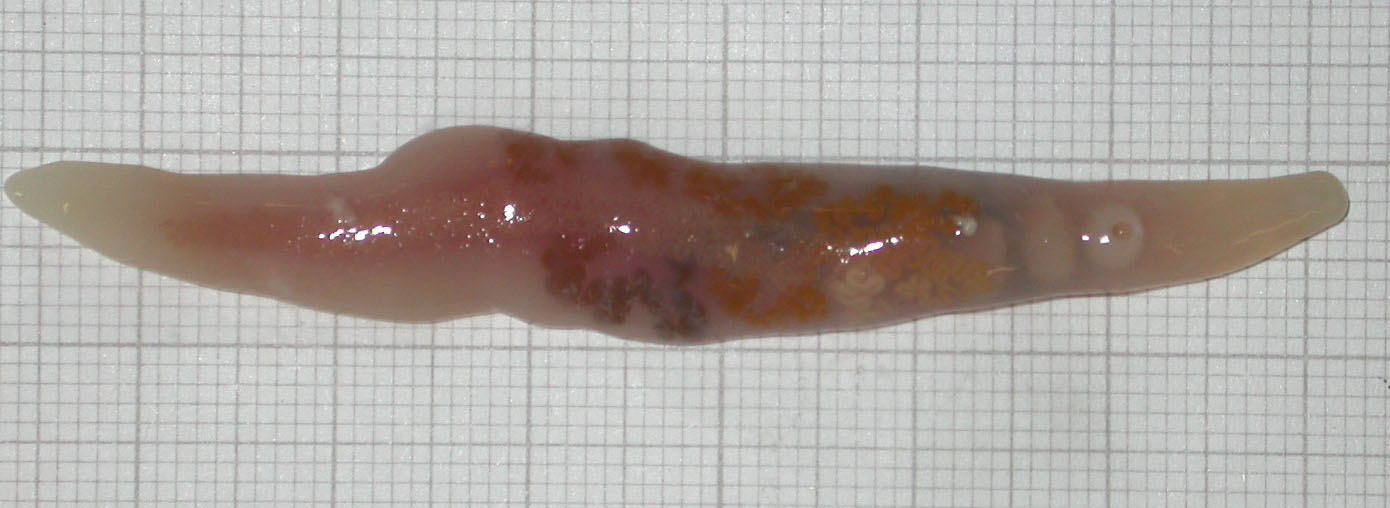Trematoda
| Trematoda | ||||||
|---|---|---|---|---|---|---|
 Botulus microporus, a giant digenean parasite from the intestine of a lancetfish
| ||||||
| Scientific classification | ||||||
| ||||||
| Subclasses | ||||||
|
WikiDoc Resources for Trematoda |
|
Articles |
|---|
|
Most recent articles on Trematoda |
|
Media |
|
Evidence Based Medicine |
|
Clinical Trials |
|
Ongoing Trials on Trematoda at Clinical Trials.gov Clinical Trials on Trematoda at Google
|
|
Guidelines / Policies / Govt |
|
US National Guidelines Clearinghouse on Trematoda
|
|
Books |
|
News |
|
Commentary |
|
Definitions |
|
Patient Resources / Community |
|
Patient resources on Trematoda Discussion groups on Trematoda Directions to Hospitals Treating Trematoda Risk calculators and risk factors for Trematoda
|
|
Healthcare Provider Resources |
|
Causes & Risk Factors for Trematoda |
|
Continuing Medical Education (CME) |
|
International |
|
|
|
Business |
|
Experimental / Informatics |
Editor-In-Chief: C. Michael Gibson, M.S., M.D. [1]
Overview
The Trematoda is a class within the phylum Platyhelminthes that contains two groups of parasitic worms, commonly referred to as flukes.
Taxonomy and biodiversity
The Trematoda are estimated to include 18 000[1] to 24 000[2] species, and are divided into two subclasses. Nearly all trematodes are parasites of molluscs and vertebrates. The smaller Aspidogastrea, comprising about 100 species, are obligate parasites of molluscs and may also infect turtles and fishes, including cartilaginous fishes. The Digenea, which constitute the majority of trematode diversity, are obligate parasites of both molluscs and vertebrates, but do not occur in cartilaginous fishes. Crepidostomum sp. do occur in Lake Sturgeon.
Formerly the Monogenea were included in the Trematoda on the basis that these worms are also vermiform parasites, but modern phylogenetic studies have raised this group to the status of a sister class within the Platyhelminthes, along with the Cestoda.
Etymology
Trematodes are commonly referred to as flukes. This term can be traced back to the Saxon name for flounder, and refers to the flattened, rhomboidal shape of the worms.
The flukes can be classified into two groups, on the basis of the system which they infect in the vertebrate host. Tissue flukes infect the bile ducts, lungs, or other biological tissues. This group includes the lung fluke, Paragonimus westermani, and the liver flukes, Clonorchis sinensis and Fasciola hepatica. Blood flukes inhabit the blood in some stages of their life cycle. Blood flukes include species of the genus Schistosoma.
Life cycles
All trematodes infect molluscs and most have a complex life cycle involving other hosts. Most trematodes are monoecious and alternately reproduce sexually and asexually. The two main exceptions to this are the Aspidogastrea, which have no asexual reproduction, and the schistosomes, which are dioecious.
In the definitive host, in which sexual reproduction occurs, eggs are commonly shed along with host feces. Eggs shed in water release free-swimming larval forms that are infective to the intermediate host, in which asexual reproduction occurs.
References
- ↑ Cribb, T.H., R.A.Bray, D.T.J. Littlewood, S.P. Pichelin and E.A. Herniou. 2001. The Digenea in D.T.J. Littlewood and R.A. Bray, eds. Interrelationships of the Platyhelminthes pp 168-185. Taylor & Francis, London.
- ↑ Poulin, R. and S. Morand. 2004. Parasite Biodiversity. Smithsonian Books, Washington. 216 pp.
cs:Motolice
de:Saugwürmer
hr:Metilji
it:Trematoda
lv:Trematodes
mk:Метили
nl:Trematoda
no:Ikter
simple:Trematoda
sk:Motolice
sl:Sesači
sr:Метиљ